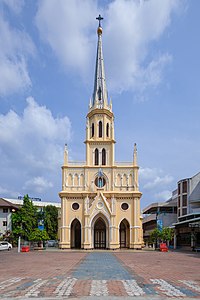Holy Rosary Church, Bangkok
| Holy Rosary Church | |
|---|---|
| Kalawar Church | |
| วัดแม่พระลูกประคำ (กาลหว่าร์) | |
 |
|
| 13°43′53″N 100°30′49″E / 13.73139°N 100.51361°ECoordinates: 13°43′53″N 100°30′49″E / 13.73139°N 100.51361°E | |
| Location | Bangkok |
| Country | Thailand |
| Denomination | Catholic |
| Website | rosary |
| History | |
| Founded | 1787 |
| Events | Rebuilt in 1838 & 1897 |
| Architecture | |
| Status | Parish church |
| Architect(s) | Father Desalles |
| Style | Gothic Revival |
| Years built | 1891–97 |
| Construction cost | 77,000 baht |
| Administration | |
| Archdiocese | Bangkok |
The Holy Rosary Church (Thai: วัดแม่พระลูกประคำ), also known as Kalawar (กาลหว่าร์, from Portuguese: Calvario), is a Roman Catholic church in Bangkok. It is located in Samphanthawong District, on the eastern bank of the Chao Phraya River. The history of the church dates to 1769, when a group of Portuguese Catholics resettled in the area after the fall of Ayutthaya; the current church building, in Gothic Revival style, was built in 1891–97 on the site of two previous structures.
When King Taksin established Thonburi as his capital following the fall of Ayutthaya in 1767, the Portuguese communities of Ayutthaya resettled in two areas of present-day Bangkok. Some followed the leadership of Father Jacques Corre, and settled on the west bank of the Chao Phraya River in the area now known as Kudi Chin where the Santa Cruz Church was soon established. Another faction, who had refused to accept the authority of the French Mission, settled on the eastern bank in an area now within Samphanthawong District. The latter brought with them two holy images: one of Our Lady of the Rosary, and the other of the Corpse of Christ. But without resident priests, they had no choice but to worship at Santa Cruz.
A church was first built at the site in 1787. It was a stilted wooden structure. The residents, however, still had to rely on French priests, whom they gradually accepted. In 1822, the church finally established communion with the Holy See, coming under the authority of Bishop Esprit-Marie-Joseph Florens, the Vicar Apostolic of Siam. By then, the Portuguese community was gradually dispersing, and Chinese immigrants soon became the church's main attendees.
...
Wikipedia
